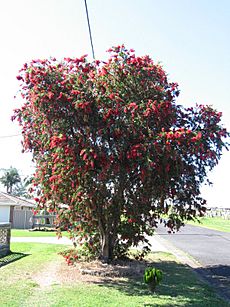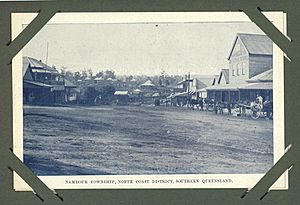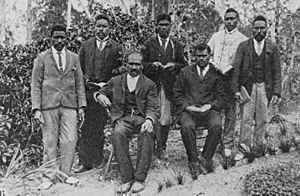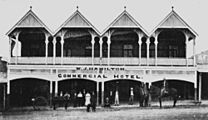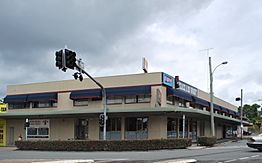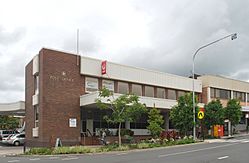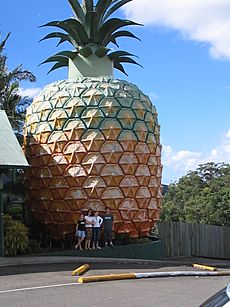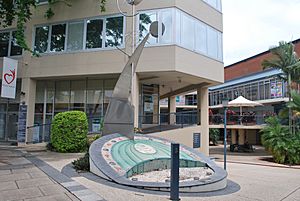Nambour facts for kids
Quick facts for kids NambourSunshine Coast, Queensland |
|||||||||||||||
|---|---|---|---|---|---|---|---|---|---|---|---|---|---|---|---|
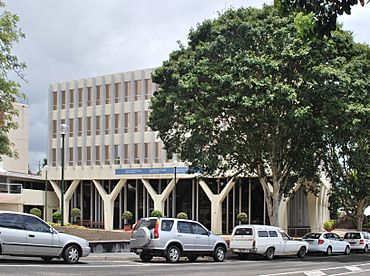
Nambour's Sunshine Coast Regional Council offices
|
|||||||||||||||
| Population | 11,187 (2016 census) | ||||||||||||||
| • Density | 981/km2 (2,540/sq mi) | ||||||||||||||
| Established | 1870 | ||||||||||||||
| Postcode(s) | 4560 | ||||||||||||||
| Elevation | 36 m (118 ft) | ||||||||||||||
| Area | 11.4 km2 (4.4 sq mi) | ||||||||||||||
| Time zone | AEST (UTC+10:00) | ||||||||||||||
| Location |
|
||||||||||||||
| LGA(s) | Sunshine Coast Region | ||||||||||||||
| State electorate(s) | Nicklin | ||||||||||||||
| Federal Division(s) | Fairfax | ||||||||||||||
|
|||||||||||||||
|
|||||||||||||||
Nambour is a rural town and locality in the Sunshine Coast Region, Queensland, Australia. In the 2016 census the locality of Nambour had a population of 11,187 people.
Contents
Geography
Nambour is 101 kilometres (63 mi) north of the state capital, Brisbane. The town lies in the sub-tropical hinterland of the Sunshine Coast at the foot of the Blackall Range It was the administrative centre and capital of the Maroochy Shire and is now the administrative centre of the Sunshine Coast Region. The greater Nambour region includes surrounding suburbs such as Burnside, Coes Creek, and Perwillowen.
Etymology
The name is derived from the Aboriginal word "naamba", referring to the red-flowering bottle brush Callistemon viminalis.
History
In 1862, Tom Petrie with 25 Turrbal and Kabi Kabi men including Ker-Walli, Wanangga and Billy Dinghy entered Petrie's Creek with the view to exploit the large cedar growing in the vicinity. They encountered some resident Aboriginal people with whom they had a traditional ceremony together. Petrie's group afterwards made a permanent logging camp further up the creek in the area now known as Nambour. At this camp, the Aboriginal workers requested that Petrie brand them with his logging symbol. With a piece of prepared glass, he cut his logging symbol of a P inside a circle into each of the men's arms. These Aboriginal workers, as well as local Maroochy men such as Puram, worked hard, returning frequently with Petrie to build the roadway, fell the timber and transport the logs downriver. The Nambour area had its first permanent European settlement in 1870. The town was then still just called Petrie's Creek.
Maroochy Provisional School opened on 13 October 1879. It was renamed Nambour Provisional School in 1891. It became Nambour State School in 1897. It had a secondary school department from circa 1940 until 2 February 1953, when Nambour State High School opened on 2 February 1953.
Petrie's Creek Post Office opened on 1 June 1888 (a receiving office had been open from 1885, originally known as Carrollo) and was renamed Nambour by 1890.
In 1890 the Maroochy Divisional Board was established.
In 1891, the North Coast railway to Brisbane was completed, and at its opening Petrie's Creek was renamed "Nambour", after the Nambour cattle station.
On Monday 2 January 1893, St Joseph's Catholic Church was officially opened by Archbishop Robert Dunne. It was at 177 Currie Street (26°37′48″S 152°57′37″E / 26.6300°S 152.9604°E) on a 5-acre (2.0 ha) site donated by Daniel Currie (after whom Currie Street was named). It was 30 by 20 feet (9.1 by 6.1 m). Circa 1950, it was demolished to make way for a new church. The timber from the demolished church was used to construct Our Lady Star of the Sea (Stella Maris) in Maroochydore as a cost-saving measure. On Sunday 16 April 1950, Archbishop James Duhig laid the foundation stone for the new St Joseph's. On Sunday 1 July 1951, Duhig returned to bless and dedicate the new St Joseph's Church.
The Moreton Central Sugar Mill Cane Tramway was constructed from 1897. It was used to transport passengers and sugar cane. The tramway closed at the end of 2001. Much of the track and signal lighting still remains. A section of the track can still be seen in central Nambour along the roadway of Mill, Currie and Howard Streets.
Nambour Baptist Church opened in July 1914 on the corner of Currie Street and Mill Street (approx 26°37′36″S 152°57′32″E / 26.6268°S 152.9588°E). On 25 August 1921 a new church was opened. Another new church opened on Sunday 2 November 1952 on the south-west corner of Currie and Bury Streets (26°37′41″S 152°57′33″E / 26.6281°S 152.9591°E). Circa 1970s the site was used to construct a new library.
A fire in 1924 destroyed many of the timber buildings along the main street.
The Nambour branch of the Queensland Country Women's Association was founded on 1 November 1928. In 1931 they established their QCWA Rest Rooms in the Shire Hall. In September 1958 they officially opened their own building at 10 Short Street (still in use today).
St Joseph's Primary School was opened on 2 February 1925 by the Good Samaritan Sisters. From 1940 to 1977 it also provided secondary schooling, an arrangement that ended when St Joseph's High School was established in 1977.
Nambour State High School opened on 2 February 1953.
Nambour Infants State School opened on 23 January 1961 and closed on 12 December 1980.
In 1977 the Catholic Education Office established St Joseph's High School. In 1979 it moved to a new location in Burnside and in 1985 was renamed St John's College.
The Nambour Public Library opened in 1982 and had a major refurbishment in 1998 with a minor refurbishment in 2016.
The town was bypassed by the Bruce Highway on 16 October 1990, which now forms the locality's north-eastern boundary. This alleviated most of the local traffic congestion.
Nambour Centre for Continuing Secondary Education opened on 4 February 1991. It was subsequently amalgamated into the Nambour State College.
The Nambour & District Historical Museum, more widely known as the Nambour Museum began with an opening ceremony held on 20 April 1996.
In the 2011 census, Nambour had a population of 10,221.
In the 2016 census, the locality of Nambour had a population of 11,187 people.
Heritage listings
Nambour has a number of heritage-listed sites, including:
- Mill Street, Currie Street, Howard Street: Moreton Central Sugar Mill Cane Tramway
- 17 & 19 Mill Street, and 14 & 16 Bury Street: former Moreton Central Sugar Mill Worker's Housing
Another heritage listing associated with the Moreton Central Sugar Mill is the
- Store Road, Maroochy River: Tramway Lift Bridge over Maroochy River
Economy
Nambour's primary industry has been sugar, with extensive cane fields surrounding the town, and the Moreton Central Sugar Mill in the town centre. The mill itself began operating in 1897 until it was closed in 2003.
The future of the sugar industry in the area is in doubt, with a number of former cane farms being converted to grazing cattle, turf farms or sold to property developers. Other industries in the area include tourism, and the growing of tropical fruits.
Situated near Nambour is the Queensland Government's Maroochy Research Station which is a major subtropical fruit and nut research and extension centre. The 61 ha research facility was established in 1945, and has an office and laboratory complex, glasshouses, netted orchards, postharvest coolrooms and a biotechnology facility. With access to national and international funding sources, specialist staff often work in conjunction with investigators from other research agencies.
Attractions
The Big Pineapple tourist attraction on the southern outskirts of the town reflects both of these pursuits.
Other tourist attractions include Thrill Hill Waterslide Park, and the Big Macadamia nut.
Events
The Big Pineapple Music Festival attracts thousands of visitors to Nambour.
Transport
The TransLink Transit Authority (known as TransLink) is the authority that coordinates and integrates the public rail and bus services in South-East Queensland, of which Nambour is in Zone 6.
Nambour is serviced by several Queensland Rail passenger trains, including the Tilt Train and is approximately one and a half hours north of Brisbane by rail. Regular services depart from Nambour railway station and use the Sunshine Coast line.
The region connected to Brisbane via the Bruce Highway which forms part of the M1 motorway.
Greyhound Australia interstate coach operators also operate daily bus services to Brisbane using the major corridors. The local bus service is operated by Sunbus Sunshine Coast which has various routes between Nambour and Noosa and the Sunshine Coast, including one via Eumundi.
Nambour is also served by Sunshine Coast Airport. The airport is approximately 25 minutes east of Nambour by car. Brisbane Airport is approximately one hour and ten minutes south of Nambour by car.
Utilities
The distribution network company that provides electricity to Nambour residents is Energex. On 1 July 2010, Sunshine Coast Regional Council's Water Services (along with Moreton Bay Regional Council), moved over to the recently created water body, Unity Water. Unity Water was created by the Queensland Government as part of the State's takeover of South East Queensland's water facilities, dams and water supply networks. Moreton Bay and Sunshine Coast Regional Councils own 50% of Unity Water.
Education
Nambour State College is a government primary and secondary (Prep-12) school for boys and girls at 1 Carroll Street (26°37′24″S 152°57′44″E / 26.6232°S 152.9623°E). In 2017, the school had an enrolment of 1,538 students with 147 teachers (134 full-time equivalent) and 83 non-teaching staff (60 full-time equivalent). Its primary (Prep-6) campus is at Coronation Avenue (26°37′16″S 152°57′53″E / 26.6212°S 152.9646°E). The school has a primary and secondary special education program. It also has a primary and secondary Intensive English program.
St Joseph's Primary School is a Catholic primary (Prep-6) school for boys and girls at 177 Currie Street (26°37′48″S 152°57′36″E / 26.6300°S 152.9601°E). In 2017, the school had an enrolment of 396 students with 23 teachers (21 full-time equivalent) and 19 non-teaching staff (11 full-time equivalent).
Agnew School is a private primary and secondary (3-12) campus of Agnew School (at Wakerley, Brisbane) at 281 Windsor Road (26°37′15″S 152°56′04″E / 26.6209°S 152.9345°E).
In addition, other suburbs of Nambour include the following schools:
- Burnside:
- Burnside State School (primary)
- Burnside State High School (secondary)
- Nambour Special School on Windsor Drive for children aged 5 to 18 years.
- St John's College (Catholic secondary)
- Sunshine Coast Institute of TAFE has its largest campus in Nambour.
- Kureelpa
- Blackall Range Independent School (primary and secondary)
- Woombye
- Woombye State School (primary)
- Nambour Christian College (secondary)
- Suncoast Christian College (secondary)
- Woombye State School (primary)
Culture
Arts and entertainment
The Nambour Civic Centre is an arts and entertainment venue that includes cinema, music, theatre, dance and other events. The Nambour Lind Lane Theatre is another live theatre venue.
Nambour Originals (sibling of Peregian Originals held at Peregian Beach) is an open air community event that involves live music in a picnic style format. It is held at 1pm every 2nd and 4th Sunday of each month at Quota Park Amphitheatre on Matthews Street. The facilities at Quota Park include barbecues, a sheltered area, shady trees, a kids play area, toilets and parking.
The Nambour Festival, which began as the Nambour Sugar Festival in the 1980s, has been held at Quota Park since 2008. The festival showcases local musicians, entertainers, cooking demonstrations, local produce, a diverse range of activities for children, and market stalls.
The Sunshine Coast Agricultural Show was first held in 1905 in Woombye. The first show in Nambour was held in 1909. Today, the Sunshine Coast Agricultural Show is a modern three-day show full of agricultural, community and entertainment events.
The Queensland Home Garden Expo is a three-day gardening event held at the Nambour Showgrounds.
Nambour is the fifth town mentioned in the original (Australian) version of the song "I've Been Everywhere".
Media
The daily local newspaper is the Sunshine Coast Daily which is published by APN News & Media. There is also a weekly news service provided by the Nambour Weekly which is published on Wednesdays. The Nambour Chronicle was published from 1903 until it ceased publication in the 1980s.
Nambour is also in the television broadcast licence areas of Brisbane (metro), enabling most areas of the Sunshine Coast to receive the commercial Brisbane stations.
Many community access stations, as well as some Brisbane stations can also be received.
Amenities
The Sunshine Coast Regional Council operates a public library in Nambour at the corner of Bury and Currie Streets.
The Nambour branch of the Queensland Country Women's Association meets at 10 Short Street.
Nambour Wesleyan Methodist Church is at 165 Perwillowen Road, Perwillowen. It is part of the Wesleyan Methodist Church of Australia.
The main shopping areas in Nambour are Nambour Plaza which has approximately 40 stores, Nambour Mill Village Shopping Centre and Centenary Square Shopping Centre.
Sport
Nambour has a number of amateur sporting clubs including:
- Nambour-Yandina United Football Club
- Nambour and District Tennis Association
- Nambas Tennis Club.
- Nambour Golf Club
The Nambour Wildcats Soccer Club is part of the Sunshine Coast Churches Soccer Association and was established in 1976, it is one of the largest sporting clubs in the region with over 350 players from U6 to senior Mens, Ladies and Over 35's.
The Nambour Crushers Rugby League Club was established in 1985. The grounds are situated at 22 Crusher Park Drive. The Crushers have teams in all grades from Under 7s to A Grade and number approximately 300 players.
The Nambour Rugby Union Club entered the Sunshine Coast District Rugby Union Competition in 1981. The club is known as the "Toads". The club's ground is situated on Laidlaw Road in nearby Woombye. Nambour fields four "Senior" sides in the Sunshine Coast Competition: A Grade, Reserve Grade and U19's as well as a women's team. A junior club with teams from under 7s through to under 17s also runs. Nambour were local premiers in 1912 and 1913.
The Nambour and Districts Netball Association is made up of clubs from Yandina, Burnside, Nambour, Woombye, Palmwoods and the school based Saints club.
Nambour Cricket Club is part of the Sunshine Coast Cricket Association and has played on the Nambour showgrounds since the early 1890s when a Nambour team competed against teams from nearby towns.
The Nambour Aquatic Centre is located in Petrie Park and has heated pools all year round. The complex offers a variety of activities including a 50m heated pool, a 25m heated enclosed pool, toddler pools and fountains/play area, a learn to swim program, aqua aerobics classes, and a poolside cafe.
Climate
| Climate data for Nambour DPI | |||||||||||||
|---|---|---|---|---|---|---|---|---|---|---|---|---|---|
| Month | Jan | Feb | Mar | Apr | May | Jun | Jul | Aug | Sep | Oct | Nov | Dec | Year |
| Average high °C (°F) | 29.3 (84.7) |
28.8 (83.8) |
27.9 (82.2) |
26.2 (79.2) |
23.7 (74.7) |
21.6 (70.9) |
21.1 (70.0) |
22.5 (72.5) |
24.8 (76.6) |
26.7 (80.1) |
27.9 (82.2) |
29.1 (84.4) |
25.8 (78.4) |
| Average low °C (°F) | 19.3 (66.7) |
19.6 (67.3) |
18.2 (64.8) |
15.4 (59.7) |
12.0 (53.6) |
9.2 (48.6) |
7.6 (45.7) |
7.9 (46.2) |
10.5 (50.9) |
13.8 (56.8) |
16.2 (61.2) |
18.0 (64.4) |
14.0 (57.2) |
| Average precipitation mm (inches) | 229.5 (9.04) |
259.1 (10.20) |
227.9 (8.97) |
143.7 (5.66) |
135.4 (5.33) |
87.9 (3.46) |
82.6 (3.25) |
59.8 (2.35) |
49.2 (1.94) |
104.0 (4.09) |
137.9 (5.43) |
174.4 (6.87) |
1,693.8 (66.69) |
| Average precipitation days | 11.1 | 12.8 | 13.3 | 9.8 | 9.0 | 6.3 | 5.5 | 5.0 | 5.3 | 8.0 | 8.9 | 9.9 | 104.09 |
| Source: Bureau of Meteorology | |||||||||||||
Demographics
According to the 2016 census of Population, there were 11,187 people in Nambour.
- 52.9% of the population were female and 47.1% were male
- The median age was 40 years
- Aboriginal and Torres Strait Islander people made up 4.4% of the population.
- 77.1% of people were born in Australia. The next most common countries of birth were England 4.0% and New Zealand 3.6%.
- 87.7% of people spoke only English at home.
- The most common responses for religion were No Religion 33.5%, Catholic 16.0% and Anglican 13.5%.
Notable people
Entertainment
- Sam Atwell, actor
- Mike Chapman, record producer and songwriter who was a major force in the British pop music industry in the 1970s
- Jon Coghill, Powderfinger drummer
- Judith Durham, lead vocalist for The Seekers
- Benjamin Law, writer, author and comedian
- Ivan Sen, filmmaker
Sport
- Scott Anderson, rugby league
- Ian Baker-Finch, 1991 British Open winner
- Lee Carseldine, cricketer
- Jake Friend, rugby league
- Angela Kennedy, Olympic swimmer
- Rhys Magin, AFL player
- Reed Mahoney, rugby league
- Casey McGuire, rugby league
- Ashley Noffke, cricketer
- Joel Parkinson, surfer
- Pat Rafter, tennis player made his debut in Nambour. His name has been on the wall of the local tennis club since he won the junior championship as a sixteen-year-old.
- Clint Robinson, canoeist
- Billy Slater, rugby league
Other
- Max Gaylard, United Nations Assistant Secretary-General currently working as Deputy Special Coordinator for the Middle East Peace Process and United Nations coordinator for humanitarian and development activities in the Occupied Palestinian Territory.
- Daniel Keighran, awarded Australia's military highest honour, the Victoria Cross for Australia for bravery during the Battle of Derapet in Afghanistan in 2010.
See also
 In Spanish: Nambour para niños
In Spanish: Nambour para niños



